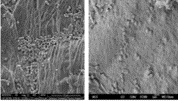Abstract
The aim of the study is to assess the antibiofilm activity of ethanolic extracts of few Indian traditional herbal plants against Staphylococcus aureus biofilm along with phytochemical analysis of plant extracts and identification of active compounds. Broth micro-dilution method was followed for minimal inhibitory concentration (MIC) and minimum bactericidal concentration (MBC) study of the plants against Staphylococcus aureus ATCC 25923. Chitin was used as a substrate for biofilm formation and antibiofilm activity of plant extract was investigated. Scanning electron microscopy (SEM) and Fourier-transform infrared spectroscopy (FT-IR) of the chitin flakes were analysed to determine the inhibitory effect of the plant extract on Staphylococcus aureus biofilm. Curcuma longa showed the best antibacterial activities where MIC and MBC were 0.4 mg/ml and 1.60 mg/ml respectively. Viability cell counts of both planktonic and sessile condition of Staphylococcus aureus showed that C.longa ethanolic extract have an antibiofilm activity. The major compounds of C.longa extract was found to be curcumin, which responded for antibiofilm activity against S. aureus. Curcuma longa rhizome and its active compound curcumin can be a potential natural source of antibiofilm agents against infectious biofilm forming Staphylococcus aureus.
Full text article
Authors

This work is licensed under a Creative Commons Attribution-NonCommercial-NoDerivatives 4.0 International License.

